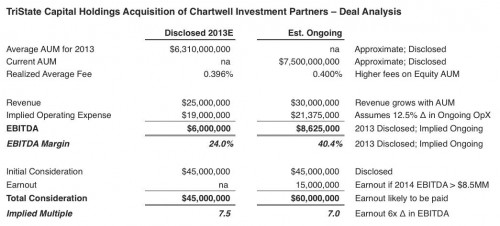Tri-State Capital’s Acquisition of Chartwell Investment Partners: A Blueprint for Asset Manager Transactions
On January 7, 2014 Tri-State Capital Holdings, Inc. (NASDAQ ticker: TSC), the holding company of Pittsburgh-based TriState Capital Bank, entered a definitive asset-purchase agreement to acquire Chartwell Investment Partners, L.P., a Registered Investment Advisor (RIA) in the Philadelphia area with approximately $7.5 billion in assets under management (AUM). Unlike most acquisitions of closely held RIAs, the terms of the deal were disclosed via a conference call and investor presentation; the details of which are outlined below.
In the call and presentation, management delineated how Chartwell’s attributes met Tri-State’s investing criteria (as shown below). Many of these features are what makes many asset managers (not just Chartwell) so appealing to both banks and non-banks – growth potential, fee income exposure, high margins, scalability, operating leverage, adhesive clientele base, and minimal capital requirements. Few businesses possess all these characteristics, making many investment advisors like Chartwell the focal point of would-be acquirers with capital to spare.
Of the nearly 11,000 RIAs nationwide, typically less than 100 (<1%) transact in a given year, and the terms of these deals are very rarely disclosed to the public. Perhaps the biggest obstacle to effectively acquiring these businesses is the difficulty and uncertainty involved with ensuring that an asset manager’s clients, staff, and operational autonomy will be preserved post transaction. In a business totally dependent upon the investing acumen and long-term client relationships of a few key individuals, executive retention is critical yet often elusive if the firm’s independence is compromised by a prospective acquirer.
Because of these circumstances, the transactions that do take place are often complemented with contingencies based on staff and client retention with some part of the consideration structured as an earn-out to ensure financial performance holds up post transaction. Tri-State’s acquisition of Chartwell contains all these provisions and relatively favorable pricing, making it a viable prototype for deal structure in asset manager transactions.
Although RIA acquisitions have been relatively scarce in recent years, the outlook is perhaps more optimistic for 2014 as AUM balances and valuations at all-time highs may induce an aging ownership base to exit the business. With so much at stake, prospective buyers and sellers should utilize the Tri-State-Chartwell acquisition blueprint in negotiating a successful transaction for both parties.
To discuss a transaction or valuation need in confidence, contact us at 901.685.2120.



